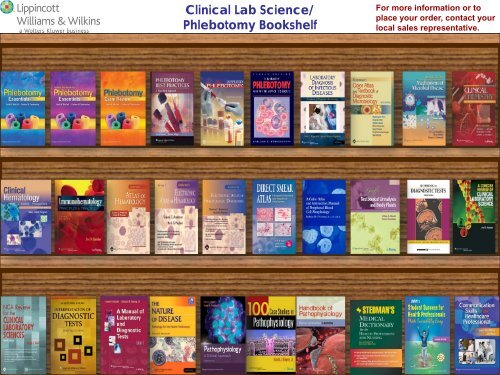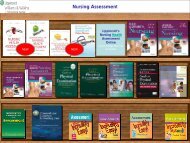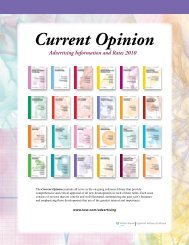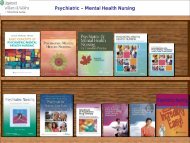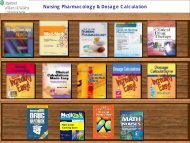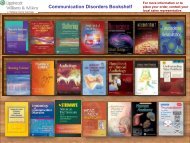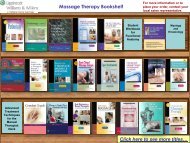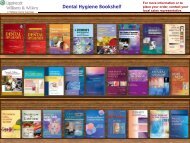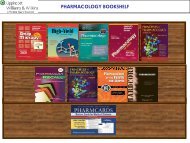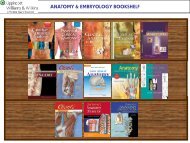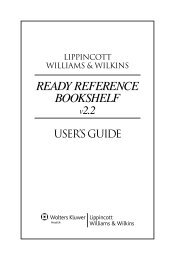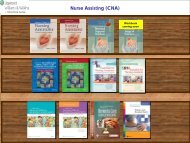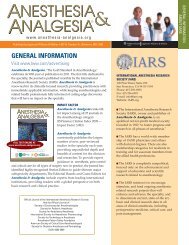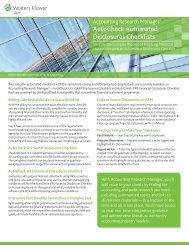Phlebotomy Bookshelf - Lippincott Williams & Wilkins
Phlebotomy Bookshelf - Lippincott Williams & Wilkins
Phlebotomy Bookshelf - Lippincott Williams & Wilkins
You also want an ePaper? Increase the reach of your titles
YUMPU automatically turns print PDFs into web optimized ePapers that Google loves.
Clinical Lab Science/<br />
<strong>Phlebotomy</strong> <strong>Bookshelf</strong><br />
For more information or to<br />
place your order, contact your<br />
local sales representative.
<strong>Phlebotomy</strong> Essentials, Fifth Edition<br />
Ruth E. McCall MT(ASCP); Cathee M. Tankersley MT(ASCP)<br />
February 2010/ 624 pp. / 235 illus. / 250 tables/ 978-1-60547-637-7<br />
Instructor Resources<br />
(online):<br />
• Lesson Plans<br />
• Critical Thinking Questions<br />
• Brownstone Test Generator<br />
• Image Collection<br />
• PowerPoint Slides with<br />
Images and Tables<br />
• WebCT- /Blackboard-ready<br />
Cartridges<br />
• Signature Papers<br />
• Log Examples<br />
• Lab Skills Evaluation<br />
Checklists<br />
Features:<br />
• NEW! Updated information and procedures incorporate the latest CLSI<br />
standards and guidelines. Added new “global harmonization” (worldwide<br />
uniformity) terms which CLSI recently adopted to align the use of<br />
terminology with that of the International Standards Organization (ISO).<br />
• NEW! Additional caution, key point, & fyi statements in many chapters<br />
• NEW! Larger trim size provides a more user-friendly reader experience.<br />
• NEW! Icons throughout the text refer readers to the McCall workbook and<br />
exam review texts.<br />
• NEW! A media menu at the end of each chapter points out online student<br />
resources available for that chapter.<br />
• Color photos throughout, including NEW Additional photos<br />
• Procedure boxes provide step-by-step directions and explanations<br />
• Two tube stopper guides serve as a quick reference for determining the<br />
appropriate type of tube for blood collection for common tests.<br />
Student Resources (online):<br />
• NEW! Interactive games<br />
• Audio flash cards<br />
• NEW! Flash card generator<br />
• NEW! Audio glossary<br />
Fully searchable full text online<br />
• Videos and animations
<strong>Phlebotomy</strong> Essentials Workbook, Fifth<br />
Edition<br />
Ruth E. McCall MT(ASCP)<br />
Cathee M. Tankersley MT(ASCP)<br />
February 2010/ 304 pp. /123 illus. / 0 tables/ 978-1-60831-119-4<br />
Features:<br />
• Order/organization of workbook chapters corresponds to the companion<br />
textbook, <strong>Phlebotomy</strong> Essentials, 5th edition.<br />
• NEW! Larger trim size provides a more user-friendly reader experience.<br />
• NEW! Main text (<strong>Phlebotomy</strong> Essentials, 5e) includes icons referencing<br />
the workbook for further opportunities to enrich student learning and<br />
which more closely links the two books.<br />
• NEW! Number of activities has increased since 4e. All chapters now<br />
consistently have all the above elements.).<br />
• All chapters include the following exercises:<br />
• Key Terms Matching<br />
• Labeling Exercises<br />
• Knowledge Drills (including Scrambled Words)<br />
• Skills Drills (including Word Building, Requisition activities)<br />
• NEW! Chapter Crossword Puzzles<br />
• Case Studies<br />
• Chapter Review Questions<br />
• Unit Crossword Puzzles
<strong>Phlebotomy</strong> Exam Review, Fourth<br />
Edition<br />
Ruth E. McCall MT(ASCP)<br />
Cathee M. Tankersley MT(ASCP)<br />
February 2011/ 480 pp. /170 illus./ 978-1-60831-120-0<br />
Features:<br />
• NEW! Improved and updated questions to meet CLSI guidelines and<br />
new material covered in the text.<br />
• NEW! Addition of second color enhances and elucidates content.<br />
• NEW! Larger trim size provides a more user-friendly reader experience.<br />
• NEW! Exam Review text includes icons referencing the main text<br />
(<strong>Phlebotomy</strong> Essentials, 5e) for further opportunities to enrich student<br />
learning. The main text includes icons referencing the exam review text.<br />
• Current information on the various exams, including names and contact<br />
information for organizations that offer phlebotomy certification exams.<br />
• A pretest and analysis to help you evaluate your knowledge and<br />
application of current phlebotomy theory.<br />
• A process for creating your very own study plan and way to track your<br />
study hours.<br />
• A section on study and test-taking skills to help ensure success on the<br />
exam .<br />
• Overview and study tips pertinent to each chapter.<br />
• Preparation tips for test-taking for ESL students.<br />
• 1,435 multiple choice questions with correct answers. Each answer has<br />
a detailed explanation of why it is correct. In addition, a sample exam<br />
with 100 questions is included.
<strong>Phlebotomy</strong> Best Practices: A Case<br />
Study Approach<br />
Carol Itatani PhD, MS, MT(ASCP)<br />
Norma Shipp MS, MT(ASCP), CLS<br />
October 2006 / 118 pp./ 37 illustrations/ 978-0-7817-7731-5<br />
Features:<br />
• 38 case studies that introduce the challenges<br />
encountered in everyday clinical practice<br />
Accompanying each case are:<br />
• Questions to test comprehension of the case<br />
• Case discussions answer the questions<br />
• Key word lists review important terminology<br />
• Quizzes at the end of each chapter include multiple<br />
choice, fill-in-the-blank, true/false, short-answer and<br />
essay questions<br />
Instructor Resources:<br />
• Instructor’s Manual<br />
• Teaching tips<br />
• Best practices in the classroom
Applied <strong>Phlebotomy</strong><br />
Dennis J. Ernst MT (ASCP)<br />
May 2005 / 283 pp./ 85 illustrations/ 978-0-7817-5055-4<br />
Features:<br />
• Step-by-step format covers terminology, equipment, and other<br />
aspects of blood collection<br />
• Clinical and Laboratory Standards Institute (formerly NCCLS) and<br />
OSHA (Occupational Safety & Health Administration) guidelines<br />
• Sidebars explain the importance of procedures and theories<br />
• Procedure Boxes encapsulate blood collection procedures briefly<br />
and step-by-step<br />
• It Could Happen To You case studies are actual <strong>Phlebotomy</strong>related<br />
injuries<br />
• Tips From the Trenches offer phlebotomy pointers<br />
• In the Lab describes what happens to blood once it is sent to the<br />
lab<br />
• Multiple-choice review questions at the end of each chapter<br />
• Color tube chart on the inside cover of the book<br />
• Lengthy discussion on the patient’s perspective
Handbook of <strong>Phlebotomy</strong> and Patient<br />
Service Techniques, Fourth Edition<br />
Garland Pendergraph PhD, SM(ASCP)<br />
Cynthia Barfield MT(ASCP)<br />
July 1998 / 175 pp./ 978-0-683-30556-2<br />
Features:<br />
• Level of detail is perfect for phlebotomy students<br />
• Provides information on ""multi-skill"" training<br />
• Techniques are discussed step-by-step<br />
• Covers canine and feline phlebotomy
Laboratory Diagnosis of Infectious<br />
Disease: Essentials of Diagnostic<br />
Microbiology<br />
Paul G. Engelkirk PhD, MT(ASCP), SM(AAM)<br />
Janet Duben-Engelkirk EdD, MT(ASCP), CLS(NCA)<br />
2007 / 754 pp./ 450 illustrations/ 978-0-7817-9701-6<br />
Features:<br />
• Effective chapter organization, grouping chapters by<br />
microorganism.<br />
• Clinical case studies and/or self-assessment questions at the end<br />
of each chapter show how to incorporate the information from<br />
the text into everyday practice.<br />
• Approaches the role of the microbiology laboratory in today's<br />
world by discussing topics such as bioterrorism, emerging<br />
infections, and healthcare epidemiology.<br />
• Essentials boxes, chapter outlines and reviews, learning<br />
objectives, study aids, key terms, and chapter summaries are<br />
provided throughout the text to help you focus on and retain<br />
crucial topics.<br />
• An exceptional art program including over 400 illustrations and<br />
visual information displays.
Koneman’s Color Atlas and Textbook of<br />
Diagnostic Microbiology, Sixth Edition<br />
Washington C. Winn Jr., MD, MBA<br />
William M. Janda PhD, D(ABMM)<br />
Paul C. Schreckenberger PhD, D(ABMM)<br />
Gail L. Woods MD<br />
Stephen D. Allen MD<br />
lmer W. Koneman MD<br />
Gary W. Procop MD, MS<br />
2005 / 1736 pp./ 1270 illustrations/ 978-0-7817-3014-3<br />
Features:<br />
• Practical guidelines provide guidance for evaluation of clinical<br />
specimens, including extent of workup and abbreviated<br />
identification schemes<br />
• Principles of biochemical tests are explained and illustrated to<br />
bridge the gap between theory and practice<br />
• Line drawings, photographs, and tables enhance the<br />
understanding of more complex concepts<br />
• Clinical correlations link microorganisms to specific disease states<br />
• Tests expressed according to the Clinical and Laboratory<br />
Standards Institute (formerly NCCLS) formation for easy adoption<br />
into laboratory procedure manuals<br />
• Organized by microorganism<br />
• Easy-to-read charts outline theory, procedure, and interpretation<br />
of tests<br />
• Display boxes highlight essential information on microbes<br />
• Various techniques and procedure charts at the back of the<br />
book
Schaechter’s Mechanisms of Microbial<br />
Disease, Fourth Edition<br />
N. Cary Engleberg MD<br />
Terry Dermody PhD<br />
Victor DiRita PhD<br />
2006 / 784 pp./ 455 illustrations/ 978-0-7817-5342-5<br />
Student Resources:<br />
• Animations<br />
• USMLE-style questions<br />
• All schematic illustrations<br />
and photographs from the<br />
text<br />
Features:<br />
• Gives a thorough understanding of microbial agents and the<br />
pathophysiology of microbial diseases<br />
• Facilitates learning and recall by emphasizing unifying principles<br />
and paradigms, rather than memorization of isolated facts by<br />
rote<br />
• Case studies with problem-solving questions give insight into<br />
clinical applications of microbiology<br />
• Each chapter ends with review and USMLE-style questions<br />
• All schematic illustrations have been re-rendered in full color<br />
and new illustrations have been added
Clinical Chemistry: Techniques,<br />
Principles, and Correlations, Sixth Edition<br />
Michael L. Bishop MS, MT(ASCP), CLS(NCA)<br />
Edward P. Fody MD<br />
Larry E. Schoeff MS, MT(ASCP)<br />
April 2009/ 832 pp./ 344 illustrations/ 978-0-7817-9045-1<br />
Instructor Resources:<br />
• Case Studies with<br />
Questions and Answers<br />
• Chapter Review Questions<br />
and Answers<br />
• Chapter Objectives,<br />
Outlines, and Summaries<br />
• PowerPoint Slides<br />
• Image Bank<br />
• Test Generator<br />
Features:<br />
• Learning aids include:<br />
− Chapter outlines and objectives<br />
− Chapter summaries<br />
− Practice questions and exercises<br />
− Expanded case studies<br />
• Clinical Applications correlate the details of the topic into a<br />
practical use<br />
• Additional case studies and questions, with more challenging<br />
and application-based exercises<br />
• Instrument manuals and kit package references for detailed<br />
instructions on current analytic procedures<br />
Student Resources:<br />
• Case Studies<br />
• Quiz Bank<br />
• Flashcards
Clinical Hematology: Theory and<br />
Procedures, Fifth Edition<br />
Mary Louise Turgeon EdD, MT(ASCP), CLS(NCA)<br />
February 2011/ 656pps/ 310illus/ 978-1-60831-076-0<br />
Features:<br />
• NEW: Fully updated to include the latest CLSI standards<br />
and guidelines. All content areas have been updated to<br />
encompass recent significant findings, including the<br />
leukemias, sickle cell anemia, and medical<br />
instrumentation.<br />
• NEW: New full-color art program engages the reader<br />
• Learning objectives provide a quick overview of content<br />
to be covered.<br />
• Case studies reinforce concepts with real-world<br />
applications.<br />
• Procedure boxes provide step-by-step information for key<br />
processes.<br />
• Review questions reinforce the student's understanding of<br />
key concepts and aid in test preparation.-Chapter<br />
highlights enable a quick review of material learned in<br />
each chapter.
Immunohematology: Principles and<br />
Practice, Third Edition<br />
Eva D. Quinley MS, MT(ASCP)SBB, CLS(NCA)<br />
February 2010 / 512 pp./ 978-0-7817-8204-3<br />
Student Resources:<br />
• Online study guide for<br />
students: Includes basic<br />
to advanced case studies<br />
and questions that are<br />
organized to be used as<br />
supplements to each<br />
chapter.<br />
• Fully searchable full text<br />
online<br />
Features:<br />
• NEW! Chapter on information technology<br />
• NEW! Chapter on principles of project management<br />
• NEW! Chapter on process management has been expanded to<br />
include information about Six Sigma and Lean Principles.<br />
• Color plates section<br />
• Chapter objectives<br />
• Chapter review questions and answers<br />
• Boxes highlighting important concepts Key Words list<br />
• References
Anderson’s Atlas of Hematology<br />
Shauna C. Anderson PhD<br />
Keila B. Poulsen MT(ASCP)SH, CLS(NCA)<br />
2003 / 424 pp./ 450 illustrations/ 978-0-7817-2662-7<br />
Features:<br />
•Well known authors that are known in the field<br />
•Follows the CLS Body of Knowledge (CLS curriculum<br />
authored by Shauna Anderson for MTs & MLTs<br />
•Format allows for bench-top access to the materials<br />
provided on CD-ROM<br />
•Side-by-side comparisons<br />
•Coverage of both normal and abnormal cells
Anderson’s Electronic Atlas of<br />
Hematology, Version 2.0<br />
Shauna C. Anderson PhD<br />
Keila B. Poulsen MT(ASCP)SH, CLS(NCA)<br />
2002 / 978-0-7817-2661-0<br />
Features:<br />
•Over 900 high-quality images<br />
•Side-by-side viewing for comparison of cells<br />
•On/off labeling function<br />
•Additional morphology evaluation questions, now 125 in<br />
total, complete with instant feedback and rationales
Electronic Atlas of Hematologic<br />
Disorders<br />
Shauna C. Anderson PhD<br />
Keila B. Poulsen MT(ASCP)SH, CLS(NCA)<br />
2003 / 978-0-7817-2645-0<br />
Features:<br />
•A diagnostic scheme provides an outline which will<br />
characterize the disorder<br />
•Each disorder is followed by various morphologic<br />
illustrations, giving the user the opportunity to use<br />
interpretive and evaluative skills.<br />
•Case studies for each disorder summarize the<br />
description and allow for better understanding<br />
•Concept applications are also included with case<br />
quizzes
Direct Smear Atlas<br />
Linda M. Marler MS, MT(ASCP)SM<br />
Jean A. Siders MS, MT(ASCP)<br />
Stephen D. Allen MD<br />
2001 / 320 pp./ 269 illustrations/ 978-0-7817-2663-4<br />
Features:<br />
•Full-color, spiral-bound manual of Gram-stained direct<br />
smears for medical technologist and laboratory technician<br />
students and practitioners, microbiologists, pathologists,<br />
infectious disease specialists, and anyone who interprets<br />
Gram-stained specimens<br />
•Over 250 clear photomicrographs taken from actual<br />
patient specimens<br />
•Brief legends accompany each image<br />
•Three introductory chapters cover Gram-stain procedures,<br />
quality control, evaluation, and more
A Color Atlas and Instruction Manual of<br />
Peripheral Blood Cell Morphology<br />
Barbara H. O'Connor MS, SH, (ASCP)<br />
1984 / 316 pp./ 978-0-683-06624-1<br />
Features:<br />
•Essential guide helps identify blood type cells, which are<br />
difficult to categorize, and explains the morphologic<br />
characteristics of peripheral blood cells in detail<br />
•Some of the book's features include:<br />
−Color photographs that depict each stage of cell<br />
maturation in the exact sequence of development<br />
−Comparative photographs of difficult-to-identify<br />
cells from different cell lines with adjacent diagrams<br />
and instructions in chart form<br />
−An explanation of the entire differential procedure,<br />
with mathematical guidelines
Graff’s Handbook of Urinalysis and Body<br />
Fluids, Second Edition<br />
Lillian Mundt<br />
Instructor Resources:<br />
•PowerPoint Slides<br />
•Image Bank<br />
•Test Generator<br />
Student Resources:<br />
•Additional Case Studies<br />
•Full-Text Online<br />
February 2010 / 400 pp./ 978-1-58255-875-2<br />
Features:<br />
•Practical handbook contains everything its user needs to know<br />
when performing routine urinalyses<br />
•Comprehensive in scope, the book discusses the formation of<br />
urine, its constituents and properties in both health and disease,<br />
the origin of these constituents, and the principles of urinalysis<br />
• NEW! Textbook tools such as chapter objectives, study questions,<br />
and a glossary frame each chapter and make the text more userfriendly<br />
for instructors and students.<br />
• NEW! Case studies help connect the content to real-life clinical<br />
situations.<br />
• NEW! Chapter objectives, study questions, glossary, case studies.<br />
• The Urinalysis images, which have been the main selling feature,<br />
have been retained, but there are more full-color images added<br />
to this edition.
Handbook of Diagnostic Tests, Third<br />
Edition<br />
Springhouse<br />
2003 / 832 pp./ 100 illustrations/ 978-1-58255-203-3<br />
Features:<br />
•Two-part organization:<br />
−Part I: Alphabetical listing of more than 500 disorders with their<br />
key test results<br />
−Part II: 16 chapters of laboratory tests and diagnostic<br />
procedures grouped by type<br />
•Clear, standard, chronological format for test entries in Part II:<br />
−Description<br />
−Purpose<br />
−Patient preparation<br />
−Procedure steps and posttest care<br />
−Precautions<br />
−Normal findings/Reference values<br />
−Abnormal findings and the disorders they confirm or suggest<br />
−Interfering factors and their effects on the test<br />
•Clinical alert icon for important clinical points concerning test<br />
administration, special posttest considerations, and results requiring<br />
immediate action<br />
•Appendices include Normal laboratory values, Normal and<br />
abnormal serum drug levels, and Illustrated guide to patient selftesting<br />
•Thirty new diagnostic tests<br />
•Thorough updating of existing tests<br />
•Addition of SI units to all laboratory tests
A Concise Review of Clinical Laboratory<br />
Science, Second Edition<br />
Joel Hubbard PhD, MT(ASCP)<br />
Instructor and Student<br />
Resources:<br />
•Image Bank<br />
•Quiz Bank<br />
•Case Studies<br />
•Full-Text Online<br />
February 2009 / 432 pp./ 135 illustrations/ 978-0-7817-8202-9<br />
Features:<br />
•Tables summarize important facts for quick reference<br />
•Figures and illustrations help students understand how to<br />
perform procedures and analyze results.<br />
•Boxes highlight calculations, formulas, and other important<br />
information and examples.<br />
•Online menus at the end of each chapter point students to<br />
supplementary web-based materials.<br />
•A concise summary of the most important facts/concepts in<br />
each subject area is presented in an outline format and is<br />
followed by study questions representing all taxonomic levels.<br />
•New chapter on Molecular Pathology is included that focuses<br />
on molecular laboratory methods and an overview on the<br />
testing of genetic diseases.<br />
•An expanded chapter dealing with Laboratory Operations is<br />
included that addresses topics such as management and<br />
organizational theory, professionalism, quality assurance,<br />
laboratory regulations, and delivery of an educational unit.<br />
•A chapter with case study examples is provided at the end of<br />
the book for practice in applied knowledge.<br />
•A complete practice exam (comparable to national<br />
certification exams) is provided at the end of the book.
NCA Review for the Clinical Laboratory<br />
Sciences, Fourth Edition<br />
Susan J. Beck PhD, CLS (NCA)<br />
May 2002 / 320 pp./ 25 illustrations/ 978-0-7817-3190-4<br />
Features:<br />
•Includes chapter review questions and practice tests—<br />
complete with answers and explanations— for both CLT<br />
and CLS<br />
•Written by practicing clinical laboratory scientists who are<br />
experts in their disciplines and are familiar with NCA Exam<br />
expectations<br />
•Provides an overall assessment of performance in all major<br />
areas of the clinical laboratory sciences<br />
•Explains the examination content, format and scoring<br />
method<br />
•Reviews test taking strategies<br />
•Includes charts, graphs, and current references for further<br />
study<br />
•Questions and answers reflecting the most recent NCA<br />
exams, NCA job analyses, and current entry level practice<br />
•Accompanying CD-ROM with an additional 500 questions,<br />
allows users to generate CLT and CLS practice exams
Interpretation of Diagnostic Tests, Eight<br />
Edition<br />
Jacques Wallach, MD<br />
2006 / 1200 pp./ 109 illustrations/ 978-0-7817-3055-6<br />
Features:<br />
•Quick, clear answers to What tests do I order, and what do<br />
the results mean?<br />
•Summarizes available tests for most diseases, explains what<br />
results mean, and discusses differential diagnoses<br />
•Arranged by organ system<br />
•Readers can search for information in the way that best<br />
suits their needs—by index, table of contents, test results, or<br />
specific disease<br />
•Includes extensive tables of normal and panic values,<br />
tables comparing test results in similar diseases, and an<br />
appendix of conversion factors between conventional and<br />
SI units<br />
•Eighth Edition highlights include:<br />
−Additional tests based on molecular biology<br />
−New data on the use of genetic tests<br />
−Many new diagnostic laboratory tests in chemistry<br />
−Imaging tests included where they play a key role in<br />
diagnosis<br />
−Expanded section on chemical and microbiological<br />
terrorism
A Manual of Laboratory and Diagnostic<br />
Tests, Eighth Edition<br />
Frances Fischbach, RN, BSN, MSN<br />
Marshall B. Dunning, III, BS, MS, PhD<br />
2008/ 1344 pp./ 22 illus./ 978-0-7817-7194-8<br />
Features:<br />
• Full-color design now more enhanced, with a better<br />
design to showcase<br />
• Covers a broad range of laboratory and diagnostic<br />
tests and studies that are delivered to varied patient<br />
populations in varied settings<br />
• Chapters organized by type of study, then into<br />
subgroups by type of test so that the student does<br />
not need to know the exact name of the test<br />
• Each test organized by specific heads, ensuring<br />
consistency and thoroughness of coverage<br />
• Headings are organized by Test Name, Normal<br />
Values, Background, Explanation of Test, Procedure,<br />
Clinical Implications, Interfering Factors, Patient<br />
Preparation, and Patient Aftercare<br />
• Clinical Alerts highlight critical safety information<br />
• Notes within the text provide helpful tips<br />
• Both conventional and SI units included<br />
• Addition of new lab tests
The Nature of Disease: Pathology for the<br />
Health Professions<br />
Thomas H. McConnell MD, FCAP<br />
Instructor Resources:<br />
•LiveAdvise<br />
•Test generator<br />
•PowerPoint slides<br />
•Lecture notes<br />
•Answers to in-text exercises<br />
•Image bank<br />
•Lesson Plan Guide<br />
Student Resources:<br />
•247-question interactive quiz bank<br />
•Animations<br />
−Acute Inflammation<br />
−Wound Healing<br />
−Neuromuscular Transmission<br />
2006/ 739 pp./ 551 illus./978-0-7817-8203-6<br />
Features:<br />
•Back to Basics provide an overview of normal anatomy and<br />
physiology<br />
•Major Determinants of Disease lists offer overview of key<br />
determinants of development of disease<br />
•Case studies center on the details of a real patient's illness<br />
•The Road Not Taken scenarios imagine how the course of<br />
disease might have been different, with a better outcome, if<br />
certain factors were altered<br />
•Test questions reinforce principles and hone skills<br />
•Opening quotes introduce each chapter with entertainment<br />
•Chapter overviews<br />
•Chapter outlines<br />
•Learning objectives and answers<br />
•Key terms and concepts<br />
•Feature boxes:<br />
−Key Points<br />
−The Clinical Side<br />
−Lab Tools<br />
−Basics in Brief<br />
−History of Medicine
Pathophysiology: A Clinical Approach<br />
Second Edition<br />
Carie A. Braun; Cindy M. Anderson<br />
Textbook: January 2011/ 608pps/ 370 illus/ 978-1-60547-304-8<br />
Study Guide: February 2011/ 176pps/ 21 illus/ 978-1-60831-187-3<br />
Instructor Resources:<br />
•Test generator<br />
•Image bank<br />
•PowerPoint slides<br />
•Answers to exercises in the text<br />
•Additional case studies<br />
Pathophysiology animations<br />
•Additional learning activities with<br />
answers<br />
•Lesson plans<br />
Student Resources:<br />
•Pathophysiology animations<br />
•Quiz bank<br />
•Interactive case studies<br />
•For sale companion study guide<br />
Features:<br />
• NEW! Fully revised chapters are now broken into modules, breaking<br />
complex information into smaller pieces and providing a building-block<br />
approach to the material.<br />
• NEW! Each chapter closes with Clinical Models, which apply the<br />
conceptual understanding of altered human function to specific<br />
conditions, and demonstrating the practical clinical application of the<br />
knowledge gained throughout the chapter.<br />
• Conceptual approach and organization facilitate application and<br />
retention of key information.<br />
Sophisticated full-color art program engages students and includes<br />
detailed illustrations of the human body in health and disease.<br />
• An application exercise in the last chapter requires students to apply the<br />
complex pathophysiologic concepts that they have learned to diabetes<br />
mellitus, emphasizing the practical nature of the material through<br />
application.<br />
• From The Lab: provides additional content on relevant laboratory and<br />
diagnostic information, including unique aspects of the lab test and lab<br />
results for students to consider.<br />
• Research: highlights new findings and demonstrates how research can be<br />
incorporated into clinical practice.<br />
Recommended Review: briefly reviews related concepts covered earlier in<br />
the text or from prior anatomy and physiology coursework.
100 Case Studies in Pathophysiology<br />
Harold J. Bruyere, Jr., PhD<br />
October 2008/ 480pp./ 978-0-7817-6145-1<br />
Instructor Resources:<br />
• Answers to the questions<br />
found in the Disease Summary<br />
and Patient Case sections<br />
• Image bank containing<br />
figures and tables<br />
Features:<br />
• Organ systems approach to categorize human diseases<br />
and other health conditions<br />
• Patient Cases incorporate new medical terms and<br />
abbreviations<br />
• Case studies are divided into a Disease Summary of a<br />
specific health condition and a relevant Patient case<br />
• Disease Summaries, on the CD-ROM, assess the student’s<br />
understanding or require the student to conduct more<br />
extensive research of the medical literature<br />
• Patient Cases, in the printed workbook, present detailed<br />
information that stimulates real-life patients<br />
• Critical thinking and problem solving questions<br />
Student Resources:<br />
• Over 150 color photographs<br />
and illustrations online & on CD-<br />
ROM<br />
• Disease Summary for each<br />
case study online & on CD-ROM
Handbook of Pathophysiology,<br />
Fourth Edition<br />
Elizabeth J. Corwin PhD, MSN, FNP<br />
October 2010 / 736 pp./ 136 illustrations/ 978-1-60547-725-1<br />
Features:<br />
•Easy reference in the classroom or clinical environment<br />
•Presents a summary of physiology concepts for each<br />
body system, followed by an overview of important<br />
pathophysiology concepts related to 'alterations' in that<br />
body system<br />
•These pathophysiology concepts provide the necessary<br />
foundation for understanding the disease or injury states<br />
that are presented next in the chapter<br />
•Includes new illustrations, completely updated<br />
references, and new and updated content on genetics,<br />
neuroendocrinology, immunology, hemodynamic<br />
monitoring, cardiovascular compensatory mechanisms of<br />
shock, and more
Stedman’s Medical Dictionary for the<br />
Health Professions and Nursing,<br />
Seventh Edition<br />
Stedman’s<br />
2011/ 2512 pp./ 1000 illus./ 978-1-60831-692-2<br />
Ancillary Assets:<br />
• More than 40,000<br />
pronunciations online<br />
• 5,600 illustrations<br />
available online<br />
Features:<br />
• Over 56,000 terms<br />
• Nearly 65 valuable appendices<br />
• 1,000 illustrations<br />
• Anatomical insert by Anatomical Chart Company<br />
• Written pronunciations for every term<br />
• British alternative spellings<br />
• Precision-cut thumb tabs<br />
• A to Z organization for easier look up<br />
• Over 70 leading consultants from the fastest growing<br />
nursing and health professions contributed to the<br />
enhancements of this latest edition<br />
• FREE One year subscription to Stedman’s Online<br />
• FREE version of Stedman’s PLUS Medical/Pharmaceutical<br />
Spellchecker ($99 value)
LWW’s Student Success for Health<br />
Professions Made Incredibly Easy,<br />
Second Edtiion<br />
<strong>Lippincott</strong> <strong>Williams</strong> & <strong>Wilkins</strong><br />
February 2011/ 326 pp./ 173 illustrations/ 978-1-60913-784-7<br />
Instructor Resources:<br />
•Test Bank<br />
•Syllabi for 8-week, 10-week, and<br />
16-week courses<br />
•PowerPoint presentations<br />
•Strategies for effective teaching<br />
•Chapter-specific teaching tips<br />
•WebCT/BB/Angel course<br />
cartridges<br />
Student Resources:<br />
•Learning styles assessment<br />
•Self-Paced Online Course<br />
•“Playing for Real” narratives<br />
•Printable planner pages<br />
•Sample cover letters and<br />
resumes<br />
•Career resource links<br />
Features:<br />
• Revised and updated with a more user-friendly organization<br />
and design, but retains the health professions focus, the<br />
concise and approachable narrative, and the fun features<br />
and art.<br />
• The first and only student success text designed specifically<br />
for health professions students and programs!<br />
•Self-Paced Online Course with activities and a final exam<br />
• Winning Strategy Lists set forth the objectives for the chapter<br />
• Playing for Real Scenarios: show students how content is<br />
applied to real-life situations in the classroom and in clinical<br />
practice<br />
• Tips from the Pros offer expert advice and proven strategies<br />
for overcoming study and test-taking problems<br />
• The Finish Line Summaries highlight the key concepts and<br />
skills that students need to master<br />
• Keeping Score Questions and Activities challenge students<br />
to consider how they will apply the content
Communication Skills for the Health<br />
Professional<br />
Laurie Kelly McCorry, PhD<br />
Jeff Mason<br />
February 2011/ 256 pp./ 50 illus./ 978-1-58255-814-1<br />
Features:<br />
• Presents the fundamentals of communication skills geared<br />
specifically for students in the allied health professions<br />
• Includes a clear, concise presentation of the principles of<br />
communication theory as well as verbal and nonverbal<br />
communication<br />
• Instructs the health care professional on communicating with<br />
patients whose ability may be impacted by anxiety, cultural<br />
differences, language differences and other situations.<br />
• Organized into three main sections outlining basic communication<br />
principles and their uses in clinical and administrative settings<br />
• Chapters on cultural sensitivity, adapting communication to adjust<br />
to a patient’s ability to understand, and dealing with other roadblocks<br />
provide students with techniques to handle many situations that they<br />
will encounter as a healthcare professional.<br />
• Role Play boxes interspersed throughout the chapters teach students<br />
how to work through various scenarios that they may encounter in<br />
practice.<br />
• Clinical applications, included in each chapter, offer more complex<br />
scenarios to aid the students in developing the critical thinking skills<br />
they will need to apply in practice.


